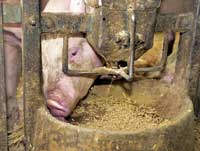Being smarter with pig feed helps raise profits

Pig farmers are being urged to optimise all aspects of pig production in a bid to offset rising feed costs.
Although rations should be reviewed to make sure the most cost effective diet is being fed, the real area for attention should be optimising production and reducing feed waste, says Premier Nutrition’s pig nutritionist Michelle Sprent.
It is vital pig farmers look at their systems and make sure they are not wasting feed. A starting point for this can be to make sure only pigs at the correct weight are selected for slaughter, says Ms Sprent.
“Going too heavy and against target specification will not only mean penalties at the abattoir end, it will also mean feed waste at the farm end,” she says.
And it’s important to invest the time when drawing pigs for slaughter. “Don’t become complacent when you think you have a good eye and weigh check a proportion of the pigs to ensure you are on track and to get the maximum return.”
BPEX knowledge transfer manager, Helen Thoday, also advises farmers to follow best practice and to fast pigs eight hours before slaughter.
“When you are feeding pigs up until the point they leave on the lorry there is a huge feed wastage. If every pig had 2kg of undigested food in its stomach and 100 pigs were sent for slaughter, then that’s 200kg of food that could have been saved. Abattoirs also don’t want full stomachs for food hygiene and disposal reasons,” she adds.
And simple things such as making sure feed bins are not leaking and that feeders are set up correctly can also help stop feed wastage, which is a big and costly problem, adds Ms Sprent.
For example, when using bagged feed, make sure starlings or other vermin do not have access to it as this is not only a biosecurity risk but it is also a costly problem.
It is also important producers minimise feed waste by making sure all food is partitioned on growth rather than on fighting disease or keeping warm, for example, adds Ms Thoday.
“When animals are out of their comfort zone it partitions a lot of energy and nutrients away from the business of laying down protein. It’s important to keep on top of issues such as health and temperature control.”
Working out the food conversion ratio in terms of what you are getting out in quantity of pig meat, compared to how much food you put in can also highlight how well feed is being used, adds Ms Thoday.
It’s also crucial to make sure pigs are on the right diet, she says. “It’s important to try and target nutrition. When health or disease profile changes or the genetics change you are feeding a different type of pig and so tweaking the diet may be necessary.”
Farmers previously keen to reduce feeds costs may also have looked at alternative protein sources such as peas and beans and synthetic amino acids, but it is unlikely these will make a great deal of difference to the ration cost, says Ms Sprent. “Peas and beans are hard to come by and the price of synthetic amino acids has increased recently, so the main way to help soften the blow is to make sure you feed efficiently.”

